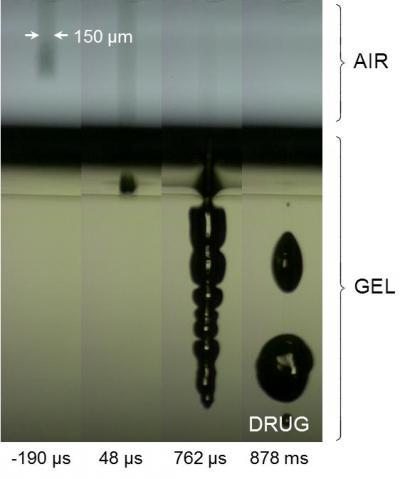In previous studies, the researchers used a laser wavelength that was not well absorbed by the water of the driving liquid, causing the formation of tiny shock waves that dissipated energy and hampered the formation of the vapor bubble. In the new work, Yoh and colleagues use a laser with a wavelength of 2,940 nanometers, which is readily absorbed by water. This allows the formation of a larger and more stable vapor bubble "which then induces higher pressure on the membrane," he explains. "This is ideal for creating the jet and significantly improves skin penetration."
Although other research groups have developed similar injectors, "they are mechanically driven," using piston-like devices to force drugs into the skin, which gives less control over the jet strength and the drug dosage, Yoh says. "The laser-driven microjet injector can precisely control dose and the depth of drug penetration underneath the skin. Control via laser power is the major advancement over other devices, I believe."

The movie shows the injector firing into open air without a skin or gel target. The jet, which is approximately the diameter of a human hair, seems dispersed but a target would be placed within the jet breakup distance of a few millimeters, so splash-free injection is achieved.
(Photo Credit: Video courtesy Jack You/Seoul National University.)
Yoh is now working with a company to produce low-cost replaceable injectors for clinical use. "In the immediate future, this technology could be most easily adopted to situations where small doses of drugs are injected at multiple sites," he says. "Further work would be necessary to adopt it for scenarios like mass vaccine injections for children."

To test the effectiveness of the drug delivery system, a special gel is used to mimic the behavior of human skin. Here the jet first creates a hole on the surface of the gel, then, at a lower jet pressure, the drug is delivered into the skin. This gel simulation also reveals that there is no splashback from the injection, which is an important patient safety factor.
(Photo Credit: Optics Letters)

This shows the beam entrance view of the laser injector.
(Photo Credit: Image courtesy Jack Yoh/Seoul National University.)
Source: Optical Society of America